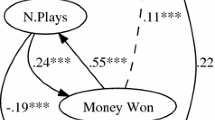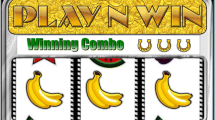Abstract
This paper reviews literature on how jackpots influence Electronic Gaming Machine (EGM) gambling behaviour. Most of the available evidence addresses the motivational effect of the mere presence of EGM jackpots on play, as actual wins are relatively rare for individual gamblers. The review identifies a distinction between rational, biased and irrational motivations that attract people to EGM jackpots. The evidence suggests that EGM jackpots should generate additional consumption on EGMs above machines that do not have such lottery-like features. Rational motivations are likely to lead to consumer surplus, whereas biased and irrational motivations are likely to contribute to excessive consumption. Moreover, there is evidence that excessive gambling consumption is strongly associated with gambling-related harm. Future research should identify how the structural features of different types of jackpots; such as progressive, deterministic, hidden, mystery, linked and wide-area jackpots; may differentially appeal to rational, biased and irrational gambling motivations. Jackpots are common feature of EGM games, and therefore it is important to have a better understanding of how jackpot features influence play on the machines.
Similar content being viewed by others
References
Ariyabuddhiphongs, V. (2011). Lottery gambling: A review. Journal of Gambling Studies, 27(1), 15–33. doi:10.1007/s10899-010-9194-0.
Bernoulli, D. (1954). Exposition of a new theory on the measurement of risk. (original 1738). Econometrica, 22(1), 23–36.
Braverman, J., & Shaffer, H. J. (2010). How do gamblers start gambling: Identifying behavioural markers for high-risk internet gambling. The European Journal of Public Health. doi:10.1093/eurpub/ckp232.
Business Pundit (2009). 10 People who won the lottery–then lost it all. The Business Pundit, from http://www.businesspundit.com/10-people-who-won-the-lottery-then-lost-it-all/.
Camerer, C. F. (1995). Individual decision making. In J. Kagel & A. E. Roth (Eds.). Princeton: Princeton U. Press.
Cook, P. J., & Clotfelter, C. T. (1993). The peculiar scale economies of lotto. The American Economic Review, 83(3), 634–643.
Currie, S. R., Hodgins, D. C., Wang, J., el-Guebaly, N., Wynne, H., & Chen, S. (2006). Risk of harm among gamblers in the general population as a function of level of participation in gambling activities. Addiction, 101(4), 570–580.
Currie, S. R., Hodgins, D., Wang, J., el-Guebaly, N., Wynne, H., & Miller, N. (2008). Replication of low-risk gambling limits using Canadian provincial gambling prevalence data. Journal of Gambling Studies, 24(3), 321–335. doi:10.1007/s10899-008-9091-y.
Custer, R. L., & Milt, H. (1985). When luck runs out: Help for compulsive gamblers. New York: Facts on File Publications.
Darke, P. R., & Freedman, J. L. (1997). The belief in good luck scale. Journal of Research in Personality, 31(4), 486–511. doi:10.1006/jrpe.1997.2197.
Griffiths, M., & Wood, R. (2001). The psychology of lottery gambling. International Gambling Studies, 1(1), 27–45. doi:10.1080/14459800108732286.
Hare, S. (2010). Player tracking and precommitment trial: A program and outcome evaluation of the PlaySmart precommitment system. Schottler Consulting Pty Ltd. Retrieved from http://www.treasury.sa.gov.au/public/download.jsp?id=3188.
Hing, N. (2007). Under the radar: what responsible gambling legislation doesn’t prevent. Paper presented to 17th Annual National Association for Gambling Studies Conference, Cairns, Qld, 14–16 November.
Hing, N. (2008). A quantitative analysis of workplace influences on responsible gambling and problem gambling amongst employees of Queensland gaming venues. Report for the Queensland Office of Gaming Regulation, Queensland Treasury by the Centre for Gambling Education and Research, Southern Cross University, Lismore NSW.
Hing, N., & Breen, H. (2005). Gambling amongst gaming venue employees: Counsellors’ perspectives on risk and protective factors in the workplace. Gambling Research, 17(2), 25–46.
Hing, N., & Haw, J. (2010). The influence of venue characteristics on a player's decision to attend a gambling venue. Final report for Gambling Research Australia by the Centre for Gambling Education & Research, Southern Cross University, Lismore, NSW.
Holtgraves, T. (2009). Gambling, gambling activities, and problem gambling. Psychology of Addictive Behaviors, 23(2), 295–302. doi:10.1037/a0014181.
Joukhador, J., Blaszczynski, A., & Maccallum, F. (2004). Superstitious beliefs in gambling among problem and non-problem gamblers: Preliminary data. Journal of Gambling Studies, 20(2), 171–180. doi:10.1023/B:JOGS.0000022308.27774.2b.
Kahneman, D., & Tversky, A. (1979). Prospect theory: An analysis of decision under risk. Econometrica, 47(2), 263.
Kaplan, H. R. (1987). Lottery winners: The myth and reality. Journal of Gambling Studies, 3(3), 168–178. doi:10.1007/bf01367438.
Kaplan, H. R. (1988). Gambling among lottery winners: Before and after the big score. Journal of Gambling Studies, 4(3), 171–182. doi:10.1007/bf01018330.
Kassinove, J. I., & Schare, M. L. (2001). Effects of the “near miss” and the “big win” on persistence at slot machine gambling. Psychology of Addictive Behaviors, 15(2), 155–158. doi:10.1037/0893-164x.15.2.155.
Knox, R. E., & Inkster, J. A. (1968). Postdecision dissonance at post time. Journal of Personality and Social Psychology, 8(4), 319–323. doi:10.1037/h0025528.
Langer, E. J. (1975). The illusion of control. Journal of Personality and Social Psychology, 32(2), 311–328. doi:10.1037/0022-3514.32.2.311.
List, J. A. (2005). A simple test of expected utility theory using professional traders. PNAS: Proceedings of the National Academy of Sciences, 102(3), 945–948. doi:10.1073/pnas.0408022101.
Livingstone, C., Woolley, R., Zazryn, T., Bakacs, L., & Shami, R. (2008). The relevance and role of gaming machine games and game features on the play of problem gamblers: Independent gambling authority South Australia prepared under the auspices of Australian Institute for Primary Care (AIPC) La Trobe University.
Marfels, C. (2001). Is gambling rational? The utility aspect of gambling. Gaming Law Review, 5(5), 459–466. doi:10.1089/109218801753204423.
McPherson, J. (2007). Beating the odds: the complete dictionary of gambling and games of chance. Docklands, VIC: GSP Books (Geoff Slattery Publishing).
Nyman, J. A., Welte, J. W., & Dowd, B. E. (2008). Something for nothing: A model of gambling behavior. Journal of Socio-Economics, 37(6), 2492–2504. doi:10.1016/j.socec.2008.02.011.
Pisaniello, S. L. (2003). The effect of varying jackpot structure and. illusory control on psychological entrapment in gambling. B of Jurisprudence, University of Adelaide.
Productivity Commission. (1999). Australia’s gambling industries Report no. 10. Canberra.
Reid, R. L. (1986). The psychology of the near miss. Journal of Gambling Studies, 2(1), 32–39. doi:10.1007/bf01019932.
Rockloff, M. (2011). Validation of the consumption screen for problem gambling (CSPG). Journal of Gambling Studies, 1–10. doi:10.1007/s10899-011-9260-2.
Rockloff, M., & Dyer, V. (2007). An experiment on the social facilitation of gambling behavior. Journal of Gambling Studies, 23(1), 1–12. doi:10.1007/s10899-006-9042-4.
Rockloff, M., & Greer, N. (2010a). Audience influence on EGM gambling: The protective effects of having others watch you play. Journal of Gambling Studies, 1–9. doi:10.1007/s10899-010-9213-1.
Rockloff, M., & Greer, N. (2010b). Never smile at a crocodile: Betting on electronic gaming machines is intensified by reptile-induced arousal. Journal of Gambling Studies, 1–11. doi:10.1007/s10899-009-9174-4.
Rockloff, M., Greer, N., & Evans, L. G. (2012). The effect of mere presence on EGM gambling. Journal of Gambling Issues.
Rockloff, M., Greer, N., & Fay, C. (2010). The social contagion of gambling: How venue size contributes to player losses. Journal of Gambling Studies, 1–11. doi:10.1007/s10899-010-9220-2.
Rockloff, M., Signal, T., & Dyer, V. (2007). Full of sound and fury, signifying something: the impact of autonomic arousal on EGM gambling. Journal of Gambling Studies, 23(4), 457–465. doi:10.1007/s10899-007-9061-9.
Rogers, P. (1998). The cognitive psychology of lottery gambling: A theoretical review. Journal of Gambling Studies, 14(2), 111–134. doi:10.1023/a:1023042708217.
Smith, V. L. (2003). Constructivist and ecological rationality in economics. American Economic Review, 93(3), 465–508.
Thaler, R., Tversky, A., Kahneman, D., & Schwartz, A. (1997). The effect of myopia and loss aversion on risk taking: an experimental test. Quarterly Journal of Economics, 112(2), 647–661. doi:10.1162/003355397555226.
The State of Queensland. (2010). Office of liquor gaming and regulation jackpot system minimum technical requirements (v 2.2). Brisbane: Department of Employment, Economic Development and Innovation.
Toneatto, T. (1999). Cognitive psychopathology of problem gambling. Substance Use and Misuse, 34(11), 1593–1604. doi:10.3109/10826089909039417.
Turner, N., & Horbay, R. (2004). How do slot machines and other electronic gambling machines actually work? Journal of Gambling Issues. doi:10.4309/jgi.2004.11.21.
Tversky, A., & Kahneman, D. (1974). Judgment under uncertainty: Heuristics and biases. Science, New Series, 185(4157), 1124–1131.
Tversky, A., & Kahneman, D. (1981). The framing of decisions and the psychology of choice. Science, 211(4481), 453–458. doi:10.1126/science.7455683.
Tversky, A., & Kahneman, D. (1992). Advances in prospect theory: Cumulative representation of uncertainty. Journal of Risk and Uncertainty, 5(4), 297–323. doi:10.1007/bf00122574.
Von Neumann, J., & Morgenstern, O. (1947). Theory of games and economic behavior (2nd ed.). Princeton, NJ: Princeton University Press.
Weatherly, J. N., Sauter, J. M., & King, B. M. (2004). The “Big Win” and resistance to extinction when gambling. Journal of Psychology, 138(6), 495–504.
Webster, M. (2006). Merriam-Webster Online Dictionary (Vol. 2006).
Wilkes, B. L., Gonsalvez, C. J., & Blaszczynski, A. (2010). Capturing SCL and HR changes to win and loss events during gambling on electronic machines. International Journal of Psychophysiology, 78(3), 265–272. doi:10.1016/j.ijpsycho.2010.08.008.
Young, M., Wohl, M., Matheson, K., Baumann, S., & Anisman, H. (2008). The desire to gamble: The influence of outcomes on the priming effects of a gambling episode. Journal of Gambling Studies, 24(3), 275–293. doi:10.1007/s10899-008-9093-9.
Acknowledgments
This review was funded by a Grant from Gambling Research Australia.
Conflict of interest
No conflicts of interest are declared.




